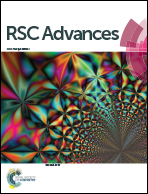Cobalt(iii) complexes with tridentate hydrazone ligands: protonation state and hydrogen bond competition†
Abstract
Cobalt(III) complexes of the type [Co(HL)(L)] were synthesized under solvothermal conditions staring from [Co(C5H7O2)3] and the corresponding ligand H2L (salicylaldehyde 4-hydroxybenzhydrazone, 3-methoxysalicylaldehyde 4-hydroxybenzhydrazone, 4-methoxysalicylaldehyde 4-hydroxybenzhydrazone, salicylaldehyde benzhydrazone, 3-methoxysalicylaldehyde benzhydrazone, 4-methoxysalicylaldehyde benzhydrazone). The presence of differently protonated forms of the same ligand in the complexes was supported by IR and NMR spectroscopy as well as by the single crystal X-ray diffraction method. The effects of weak interactions on the supramolecular architecture and their role on the ligand form stabilization have been analysed. Molecular interactions within the unit cells were investigated and quantified by extensive quantum chemical analysis on models built from crystal structures using density functional theory and empirical dispersion. Ligands used in this study were prepared under environmentally friendly conditions by mechanochemical synthesis. Their thermal behaviour and phase transitions were investigated using TG and DSC analysis and the powder X-ray diffraction method.


 Please wait while we load your content...
Please wait while we load your content...